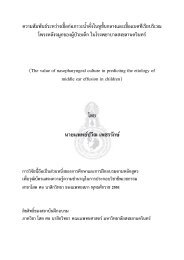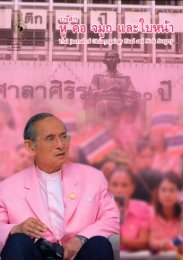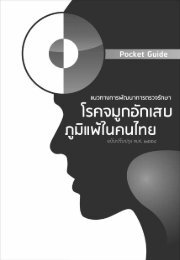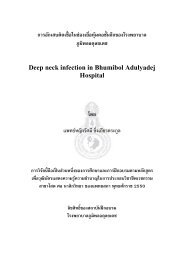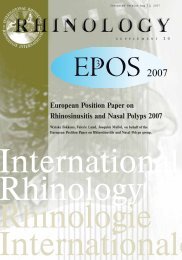Nasal provocation test: how to maximize its clinical use?
Nasal provocation test: how to maximize its clinical use?
Nasal provocation test: how to maximize its clinical use?
Create successful ePaper yourself
Turn your PDF publications into a flip-book with our unique Google optimized e-Paper software.
Asian Pac J Allergy Immunol 2010;28:225-31criteria and techniques are adapted from EuropeanResearch Centers 7 .This article summarized the <strong>use</strong>fulness ofNPT, <strong>its</strong> indication and contraindication, dosageand instillation techniques for allergens andevaluation of outcome in the hope that if we canstandardize the procedure and make it easier <strong>to</strong>perform, NPT will be applied more in <strong>clinical</strong>practice. In addition normal values among Asianethnics are presented for appropriate interpretationof the <strong>test</strong>.Application of NPT and <strong>its</strong> importanceSkin Prick <strong>test</strong>ing (SPT) is a standard <strong>test</strong>ingfor allergy diagnosis. Patients with larger whealsizes from SPT are the ones with higher <strong>clinical</strong>correlation than those with smaller wheal sizes.Some patients with negative SPTs but withpositive intradermal <strong>test</strong>s (IDT) do not react <strong>to</strong>allergen challenge. However, this has recentlybeen questioned by reports from Bodtger in 2006and Scadding in 2007. These authors reported thatpatients with ab definate allergic his<strong>to</strong>ry but withnegative skin <strong>test</strong>s could later become developboth positive skin <strong>test</strong> and NPT results 8,9 . Suchpatients with convincing allergic his<strong>to</strong>ry couldmake it difficult for clinicians <strong>to</strong> make a correctdiagnosis during their first encounter with thepatient. When there is doubt regarding thediagnosis of nasal allergy, NPT could be a <strong>use</strong>fulprocedure for such patients 10,11 . Moreover, thosewith multiple sensitivities, i.e., those who react <strong>to</strong>several allergens by skin <strong>test</strong>ings, should becandidates for NPT in order <strong>to</strong> identify the culpritallergens. Thus, such patients could be improvedthrough environmental control measures and thephysician could select appropriate allergens forallergen immunotherapy.To date, the indications of NPT are:1. To confirm the diagnosis of allergicrhinitis in patients with negative allergy skin <strong>test</strong>sor without serum specific IgE.2. To confirm the <strong>clinical</strong> relevance of aspecific airborn allergen in patients with multiplesensitivities, as determined by skin <strong>test</strong>ings 12 .3. To confirm nasal reactivity <strong>to</strong> specificallergen before initiating immunotherapy 13 .4. To assess the hyper-reactive state of nonallergicrhinitis, using capsaicin- orlipopolysaccharide (LPS)- challenge 14 .5. To confirm the role of a specific allergenin patients with bronchial asthma in whichbronchial <strong>provocation</strong> <strong>test</strong> could not be safelyperformed 7 .6. To confirm the role of a specificoccupational agent 15,16 .7. To study patho-physiology of allergicand non allergic reactions.8. For allergy research such as theidentification of new allergens or in the processof evaluating new treatments for allergicconditions.Nevertheless, NPT is still not <strong>use</strong>d as often as itcould be in <strong>clinical</strong> practice.NPT can be carried out safely with only a fewminor side effects. In order <strong>to</strong> avoid side effects,NPT should not be performed during anexacerbation of the allergic condition or inpatients with a his<strong>to</strong>ry of severe systemicreactions (anaphylactic shock) <strong>to</strong> the particularallergen of interest.To minimize false positive results, NPT shouldbe avoided during an acute episode of rhinitissince the increase vascular permeability and nasalhyper-reactivity could alter the results 17 .To minimize false negative results, certainmedications should be discontinued prior <strong>to</strong> NPT.These are listed in Table 1.Principle of NPTAn allergen extract or other provocative agents isinstilled intranasally and the intensity of nasalsymp<strong>to</strong>ms such as itching, sneezing, rhinorrheaand nasal obstruction occurred are recorded.Distant symp<strong>to</strong>ms, such as ocular and bronchial,can be observed as well. The most importan<strong>to</strong>utcome parameter is nasal obstruction which canbe assessed by various methods such as peaknasal inspira<strong>to</strong>ry flow (PNIF), rhinomanometry(RMM) or acoustic rhinometry (ARM) 19,20 .Table 1. Medications should be s<strong>to</strong>ppedbefore nasal <strong>provocation</strong> <strong>test</strong>.MedicationsDuration <strong>to</strong> s<strong>to</strong>p before nasal<strong>provocation</strong> <strong>test</strong>Oral antihistamine3 daysIntranasal corticosteroid 1 week 7 <strong>to</strong> 6 weeks 18Oral corticosteroid (greater than2 weeks10 mg/day)Topical nasal decongestant1 dayAntihypertensive (ACE inhibi<strong>to</strong>rs)3 weeks226Downloaded from http://apjai.digitaljournals.org. For personal <strong>use</strong> only. No other <strong>use</strong>s without permission.



